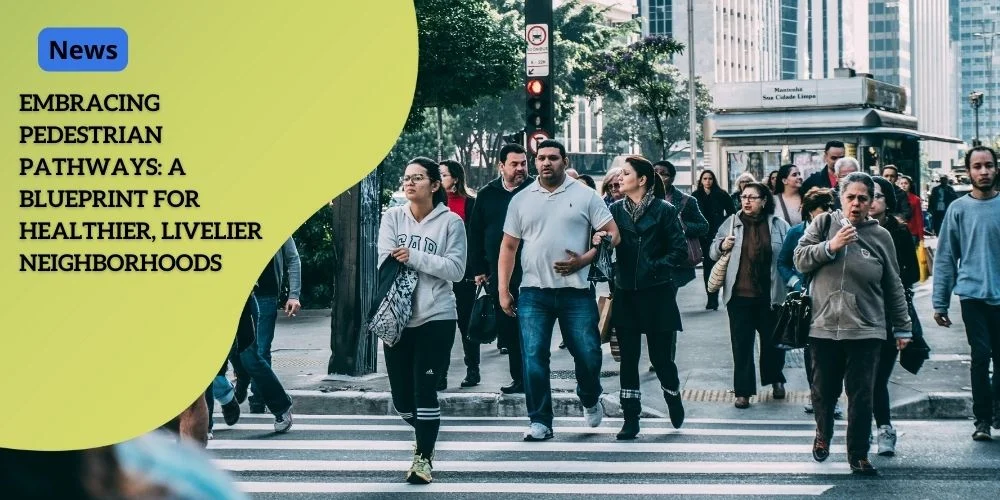Embracing Pedestrian Pathways: A Blueprint for Healthier, Livelier Neighborhoods

Anúncios
Rethinking Urban Design Priorities
Critique of Car-Centric Urban Planning
Imagine a bustling city where the loud hum of engines drowns out conversations, and the streets feel more like highways than welcoming community spaces. In many urban landscapes, this is the reality. This car-centric planning has prioritized vehicles at the expense of pedestrians, resulting in communities that feel disconnected and unsafe for walking.
Negative Impacts on Pedestrian Safety and Community Life
Car-centric streets are notorious for their lack of pedestrian infrastructure. Narrow sidewalks, high-speed traffic, and a general absence of safe crossing points make walking an unpleasant and even dangerous endeavor. This car-first mentality diminishes street activity, making neighborhoods feel isolated and void of community interactions. Without walkable spaces, neighbors miss out on the casual yet meaningful encounters that foster social bonds and community cohesion
Anúncios
The Need for a Paradigm Shift Towards Pedestrian-Centric Design
To create healthier, happier communities, a paradigm shift in urban design is essential. We need to transition from prioritizing vehicles to creating spaces that put pedestrians first. This involves designing broader sidewalks, integrating green spaces, and implementing traffic calming measures to ensure safety and accessibility for everyone. Such changes can transform streets into inviting social spaces where community life can flourish. By making these shifts, cities can become vibrant, connected, and resilient communities that prioritize well-being and sustainability. “`
Benefits of Pedestrian-Friendly Neighborhoods
Promoting Social Interaction and Community Cohesion
Designing neighborhoods that prioritize pedestrians fosters opportunities for social interaction. When sidewalks are widened and integrated with green spaces, they become inviting areas where people are encouraged to stroll, linger, and engage with each other. These enhancements transform streets and sidewalks into vibrant public spaces that act as the community’s living room.
Anúncios
Creating Spaces for Connection
Well-designed pedestrian spaces such as public squares and pedestrian plazas become natural gathering spots. These areas facilitate chance encounters and organized community events, enhancing social bonds and fostering a stronger sense of belonging among residents. Imagine a bustling plaza where local artists display their works, children play, and neighbors exchange stories—these interactions cultivate a richer, more connected community life.
Supporting Local Businesses and Economic Vitality
When neighborhoods are walkable, they naturally support local commerce. Increased foot traffic leads to higher visibility for small businesses and creates a dynamic commercial environment. Studies have shown that areas with more pedestrian-friendly designs enjoy higher retail sales and employment rates, bolstering local economies
Boosting Economic Resilience
Walkable neighborhoods with a strong pedestrian presence create a ripple effect on economic activity. Local businesses thrive as they attract more customers who enjoy the ease and pleasure of walking through lively, accessible streets. This economic vitality fosters a sense of community ownership and pride, making neighborhoods more resilient during economic downturns.
Enhancing Physical and Mental Well-Being
Pedestrian-centric design also translates to significant benefits for physical and mental health. Encouraging walking not only reduces pollution but also promotes active lifestyles. For residents, this means lower rates of chronic diseases, better mental health, and an overall improved quality of life.
Encouraging Active Lifestyles
Walkable spaces make it easier for people to incorporate physical activity into their daily routines. Whether it’s a short walk to the local café or a longer stroll through a scenic green pathway, these activities contribute to overall fitness and well-being.
Creating Inclusive Environments
Pedestrian-centric spaces are more inclusive and cater to diverse populations, including the elderly and people with disabilities. By prioritizing accessibility and safety, cities create environments where everyone can enjoy public spaces without barriers. This inclusivity fosters a sense of community and enhances overall happiness among residents. By shifting our urban design priorities towards walkability and pedestrian-friendly infrastructure, we build neighborhoods that not only thrive economically but also improve the social and physical health of their residents. Cities designed with pedestrians in mind are livelier, healthier, and more connected environments. “`
Transforming Streets and Sidewalks
Design Interventions for Pedestrian-Friendly Spaces
To revitalize our urban environments, we must reimagine streets and sidewalks as spaces for people rather than just vehicles. Various design interventions can help us achieve this transformation. Wider sidewalks and carefully integrated greenery can create more inviting pedestrian spaces, fostering a sense of belonging and community interaction. Green elements such as trees and shrubs not only beautify these areas but also provide shade and improve air quality, enhancing the overall experience of walking.
Widening Sidewalks and Integrating Greenery
Providing ample space for pedestrians is crucial to creating walkable cities. Widening sidewalks removes the sense of confinement often felt when walking along narrow pathways adjacent to busy roads. It encourages more people to walk, linger, and engage with their surroundings. In addition, introducing greenery along these sidewalks adds aesthetic value and environmental benefits. Plants can help reduce the urban heat island effect, mitigate air pollution, and create relaxing, nature-filled paths that make walking more enjoyable.
Sidewalk Cafes and Social Spaces
Widened sidewalks allow for the addition of sidewalk cafes and social spaces, creating vibrant pockets where people can relax and interact. These areas can become community hubs, boosting local businesses by drawing in more foot traffic and fostering a greater sense of community cohesion.
Green Buffers for Safety
Integrating greenery not only beautifies urban landscapes but also serves a practical function. Green buffers of plants and shrubs can act as a barrier between pedestrians and vehicular traffic, improving safety and providing a more relaxing walking environment.
Prioritizing Pedestrian Safety and Accessibility
Making urban areas more pedestrian-friendly necessitates ensuring safety and accessibility for all. Implementing traffic calming measures like raised crosswalks, speed bumps, and pedestrian islands can significantly reduce vehicular speeds, making it safer for people to walk. These features also make streets more navigable for individuals with disabilities, ensuring that urban spaces are inclusive and accessible to everyone.
Visual and Tactile Cues
To enhance accessibility, consider installing visual and tactile cues such as textured pavements and audio signals at crosswalks. These features aid visually impaired individuals in navigating urban spaces safely and independently.
Improved Lighting and Signage
Proper lighting and clear signage are essential in pedestrian-centric design. Well-lit streets and clearly marked pedestrian zones improve visibility and safety, making it easier for both pedestrians and drivers to navigate urban areas.
By adopting these strategies, cities can transform their streets and sidewalks into vibrant, welcoming spaces that prioritize people over cars. Such initiatives not only enhance pedestrian safety and comfort but also contribute to more sustainable and lively urban environments.
Source: Elevating Pedestrian Priority: Revitalizing Streets and Sidewalks for Community Connectivity
Building Sustainable Urban Environments
Reducing Reliance on Cars and Promoting Active Transportation
Urban spaces that prioritize cars often find themselves grappling with congestion, pollution, and a decreased quality of life for residents. By reducing our reliance on cars and promoting active transportation, we not only cut down on emissions but also create an environment that invites physical activity. Promoting walking and biking in urban areas can significantly lower pollution levels. Encouraging these modes of transportation also decreases traffic congestion, making streets safer and more pleasant for all users. Cities that have embraced active transportation have seen marked improvements in air quality, a reduction in noise pollution, and healthier lifestyles
Fostering Vibrant Streetscapes and Community Engagement
Transforming car-dominated streetscapes into pedestrian-friendly environments fosters vibrant, active communities. Streets become shared spaces where people can gather, interact, and engage in communal activities. When pedestrian pathways are prioritized, social interactions flourish, and neighborhoods feel more connected. Urban planners can design more welcoming streetscapes through wider sidewalks, green spaces, and pedestrian plazas. Such spaces encourage residents to spend time outdoors, meet their neighbors, and participate in local events. The ripple effect of these changes nurtures a stronger sense of community and belonging, vital for a healthy urban environment
Contributing to Environmental Sustainability
Emphasizing pedestrian pathways also has significant environmental benefits. Walkable cities reduce the urban heat island effect by incorporating more greenery and reducing asphalt coverage. Additionally, promoting active transportation cuts down on the carbon footprint associated with daily commutes. Green spaces and pedestrian-friendly zones enhance urban biodiversity and help in managing urban runoff, improving overall urban ecology. These design choices contribute to more resilient and adaptable urban environments that can better withstand climate change impacts
The Role of Community and Policies
For the shift towards sustainable urban environments to succeed, community involvement and supportive policies are crucial. Community members should engage in local planning initiatives, advocate for pedestrian-friendly policies, and support local businesses that promote foot traffic. Building sustainable urban environments is a collective effort that relies on the active participation of all stakeholders. By embracing this transformative approach, cities not only create healthier, more connected communities but also ensure a sustainable and vibrant future for generations to come. “`
A Call to Action: Embracing Pedestrian Pathways
Advocating for Pedestrian-Friendly Policies
Making cities more walkable requires robust policy advocacy. Engage with local government and urban planners to push for measures that prioritize pedestrian infrastructure. Examples include traffic calming zones, expanded sidewalks, and pedestrian-only streets. Advocacy is not just about voicing concerns but actively lobbying for change. Utilize social media, petitions, and public forums to amplify your message.
Participating in Community Planning Initiatives
Active involvement in community planning is crucial. Attend town meetings and workshops focused on urban development. Your input can directly influence the creation of pedestrian-friendly spaces. Form or join neighborhood associations that prioritize walkability and community life. These groups often have more clout when engaging with city officials and can collectively work towards creating vibrant and sustainable urban spaces.
Supporting Local Businesses Through Walking/Biking
One of the most effective ways to impact your community is by supporting local businesses on foot or by bike. Frequenting nearby shops and restaurants not only boosts the local economy but also reinforces the need for pedestrian infrastructure. Communities that center around walkable streets tend to see increased economic vitality and social interaction, making them more resilient and cohesive Source: Elevating Pedestrian Priority.
Join the Movement
To create a more pedestrian-friendly future, here are some steps you can take:
- Stay informed about pedestrian-centric design.
- Advocate for walkable communities with local representatives.
- Join neighborhood associations focused on urban design.
- Support local businesses by walking or biking to shops and restaurants.
- Document and share success stories and challenges on social media or blogs.
Remember, urban design isn’t just about infrastructure—it’s about nurturing social interaction, supporting local economies, and enhancing our overall quality of life. Join the movement to create healthier, more connected, and more vibrant






